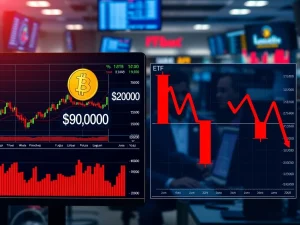Urgent Warning: Crypto Treasury Risks Mirror 2008 CDO Crisis Dangers

Are you concerned about the hidden dangers within the rapidly evolving crypto market? Recent expert warnings highlight significant Crypto Treasury Risks that echo the systemic vulnerabilities of the 2008 financial crisis. Understanding these parallels is crucial for every investor and participant in the digital asset space. This article explores how crypto treasury firms, while innovative, introduce layers of risk that could potentially destabilize the market, drawing stark comparisons to collateralized debt obligations (CDOs).
Unpacking the Shadow of CDO Crypto: A Familiar Threat?
The financial world vividly remembers the collateralized debt obligations (CDOs) that ignited the 2007-2008 financial crisis. These complex financial products bundled various types of debt, primarily subprime mortgages, into tradable securities. Their opaque nature and interconnectedness led to widespread contagion when the underlying assets defaulted. Now, a similar warning emerges from the crypto sector. Josip Rupena, CEO of lending platform Milo and a former Goldman Sachs analyst, suggests that CDO Crypto parallels exist within crypto treasury firms. He argues that these entities transform inherently low-risk bearer assets like Bitcoin into instruments carrying multiple layers of counterparty risk.
Initially, digital assets like Bitcoin offer reduced or even zero counterparty risk. You directly own your assets. However, when firms manage these assets as a treasury, they introduce new risk vectors. These include:
- Corporate Management Competence: The skill and integrity of the team managing the treasury become paramount. Poor decisions can jeopardize the entire holding.
- Cybersecurity Vulnerabilities: Centralized control of significant digital asset holdings makes firms prime targets for cyberattacks. A breach could lead to catastrophic losses.
- Business Cash Flow Reliability: The firm’s ability to generate sufficient cash flow is vital. If operations falter, it could necessitate selling treasury assets at unfavorable times.
Rupena states, “There’s this aspect where people take what is a pretty sound product, a mortgage back in the day or Bitcoin and other digital assets today, for example, and they start to engineer them, taking them down a direction where the investor is unsure about the exposure they’re getting.” This ‘engineering’ process, he implies, obfuscates the true risk profile, much like CDOs did with mortgages.
The Looming Specter of Market Contagion Crypto
While Josip Rupena does not predict crypto treasury companies will trigger the next bear market, he cautions that overleveraged firms could significantly “exacerbate” a market downturn. This exacerbation would likely occur through forced selling. Imagine a scenario where numerous firms, facing liquidity crunches or margin calls, are compelled to sell off their digital asset holdings en masse. This could lead to a rapid and severe depression of crypto prices across the board, creating a devastating Market Contagion Crypto event.
Such a scenario would impact not only the firms directly involved but also the broader market. Other investors, seeing prices plummet, might panic sell, further accelerating the decline. This domino effect is a classic characteristic of financial contagion. Several market analysts have already issued warnings about this potential. They highlight the risk that overextended crypto treasury companies could trigger widespread selling, driving down crypto prices in a frantic effort to cover their debts. The exact effects remain uncertain, but the potential for a cascading crisis is a serious consideration for the industry.
The Evolution of Bitcoin Treasury Strategy
The concept of a corporate Bitcoin Treasury Strategy gained significant traction, largely popularized by figures like Michael Saylor. His firm, MicroStrategy, famously accumulated substantial Bitcoin holdings, positioning BTC as a primary reserve asset. This strategy aimed to hedge against inflation and capitalize on Bitcoin’s long-term growth potential. Currently, 178 public companies hold Bitcoin on their balance sheets, according to BitcoinTreasuries. This widespread adoption underscores the mainstream acceptance of Bitcoin as a legitimate corporate asset.
However, the journey has not been without its challenges. The share prices of many Bitcoin treasury firms experienced slumps in the second half of 2025. This downturn occurred as the field became increasingly crowded and market conditions shifted. The volatility inherent in Bitcoin means that a treasury strategy centered solely on BTC carries considerable risk. Companies adopting this approach must carefully balance potential gains with the possibility of significant unrealized losses, which can impact their stock performance and investor confidence. The debate between proponents like Saylor and critics, such as Peter Thiel, highlights the divided opinions on whether this strategy represents a shrewd bet or a speculative bubble.
The Rise of Altcoin Treasury Diversification
Beyond Bitcoin, a growing trend sees traditional financial companies exploring Altcoin Treasury strategies. These firms are diversifying their digital asset holdings beyond just BTC, incorporating a range of altcoins into their corporate reserves. This move reflects a broader acceptance of the diverse ecosystem of cryptocurrencies and a desire to capture potential growth from other promising projects. During July and August, several companies announced corporate treasury strategies involving various altcoins, including:
- Toncoin (TON): A blockchain platform with a focus on fast, secure transactions.
- XRP (XRP): Known for its use in cross-border payments.
- Dogecoin (DOGE): A popular meme coin with a large community.
- Solana (SOL): A high-performance blockchain platform.
This diversification, while offering potential for higher returns, also introduces increased complexity and risk. Altcoins often exhibit higher volatility than Bitcoin and can be more susceptible to market sentiment and specific project developments. Therefore, a robust due diligence process is essential for any firm considering an altcoin treasury strategy.
Mixed Market Reactions to Digital Asset Pivots
The decision by companies to adopt crypto treasury strategies has elicited varied reactions from financial markets. These market responses underscore the ongoing debate and uncertainty surrounding digital assets in traditional finance. Some companies have seen positive investor sentiment, as markets view their pivot to digital assets as forward-thinking and potentially lucrative. However, others have faced significant headwinds.
For instance, Safety Shot, a health and wellness beverage maker, announced in August that it would adopt BONK (BONK) memecoin as its primary reserve asset. Following this announcement, shares of the company plummeted by 50%. This sharp decline illustrates the skepticism and apprehension that investors can harbor towards highly speculative digital asset choices, especially when they come from companies outside the tech or financial sectors. Similarly, the share prices of many Bitcoin treasury firms have experienced slumps in recent periods, as the market becomes increasingly saturated and investors scrutinize the performance and risk exposure of these strategies.
These examples highlight the critical need for clear communication and a well-defined rationale when integrating cryptocurrencies into corporate balance sheets. Investors seek transparency regarding the risk management protocols, the specific assets chosen, and the overall strategic objectives behind such decisions. The market is still in its early stages of understanding and pricing the impact of digital asset treasuries on traditional company valuations. Therefore, careful consideration and a cautious approach are paramount for any company venturing into this space.
Navigating the Future: Prudent Treasury Management
The warnings from industry experts like Josip Rupena serve as a vital reminder for all participants in the crypto ecosystem. While the potential for innovation and growth in digital assets is immense, the introduction of traditional financial risks through complex structures demands careful scrutiny. Companies engaging in crypto treasury management must prioritize transparency, robust risk assessment, and sound governance. Investors, in turn, must conduct thorough due diligence, understanding the true exposure they gain when investing in firms with significant digital asset holdings.
The crypto market continues to mature, but the lessons from past financial crises remain highly relevant. By learning from the systemic failures of CDOs and other complex financial instruments, the crypto industry can strive to build a more resilient and transparent financial future. Vigilance against overleveraging and opaque financial engineering will be crucial in mitigating potential market contagion and ensuring sustainable growth for digital assets.









